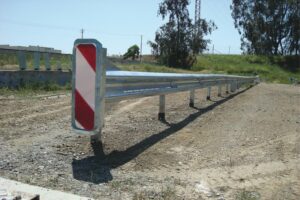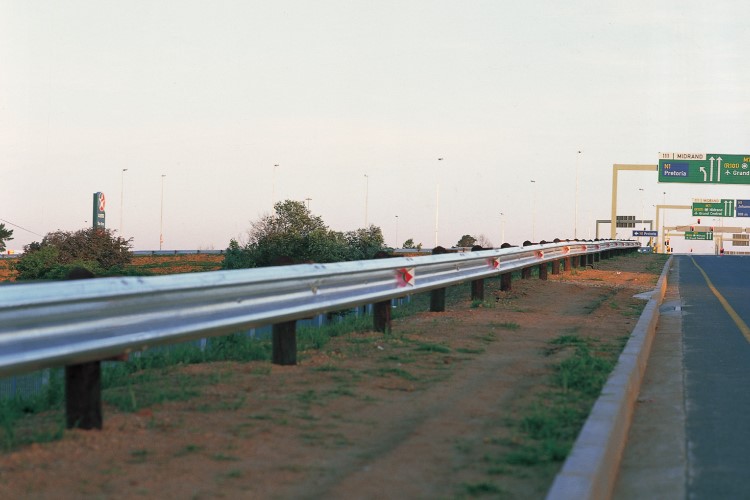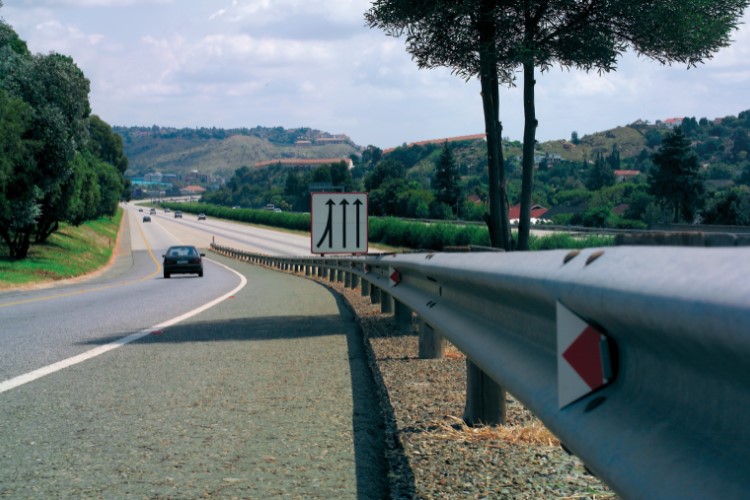A guardrail is a type of road safety device, often referred to as a traffic barrier, which is installed at dangerous sections of roads, whether on urban, rural or highway sections. Read on for more information about this traffic barrier type, including:
- Appearance
- End-terminal importance
- Best places for installation
- Top functions
See more information about the Armco barrier here.
What is a guardrail?
It’s a type of traffic barrier, specifically designed to protect motorists from direct impact with hazardous objects on the side of the road and beyond the barrier, and to prevent vehicles from leaving the safe travel path.
What does a guardrail look like?
It consists of several components like the W-beam shaped steel panels attached to wooden or steel posts, which are buried into the soil or attached to a hard surface by means of bolts. If placed in the median of two highways, then the panels are on both sides of the wooden or steel posts. The end of the barrier is buried or fitted with an end terminal, which is a solid plate.
Why is the end-terminal necessary?
It provides a safety edge to the end section of the barrier to prevent the sharp edge of the panel from penetrating the body of a vehicle that collides with the end of the barrier.
Best places to install guardrails?
These safety or traffic barriers are installed at the edge of rural and urban roads, in the medians of two opposite flowing highways, at the on and off-ramps on highways leading towards or away from tollbooths, and on bridges.
Examples of applications include:
- Mountain pass – to prevent vehicles from going over the edge of a cliff.
- Sharp turn in a road – to prevent vehicles from leaving the safety of the road.
- Bridge – to prevent vehicles from going over the edge of the bridge into a water source or onto traffic from a road below.
- Median of two opposite flowing highways – to prevent accidents from one highway spilling over to the opposite direction fast lane of another highway.
- On the median island between two highways – to prevent motorists from attempting dangerous U-turn actions into the fast lane of the opposite flowing highway.
- On- and offramp slopes – to prevent straying vehicles from going down the slopes.
- Tollbooth off- and onramps – to prevent motorists from driving around tollbooths to avoid having to pay gantry fees.
- On the edge of any section of road where there is a considerable risk of a vehicle colliding with a hazardous object, such as a streetlight, billboard, tree, or a brick-and-mortar structure.
- On the edge of an urban road – to provide an effective barrier between the road demarcated for vehicle traffic and the pavement area demarcated for cycling and foot traffic.

What are the top functions of guardrails?
As road safety barriers, these act to improve road safety conditions. This is achieved in the following ways:
- Increase visibility of the road edge and safe travel path.
- Create a strong barrier between hazards and the road.
- Redirect straying vehicles back to their original drive path upon side impact.
- Prevent breakthrough.
- Improve driver confidence at night as they provide a visible edge on the side, giving the driver the confidence to stay closer to the yellow or edge line as opposed to the median line, thereby helping to reduce a head-on collision risk.
How guardrails work
The entire system works together to absorb the kinetic impact energy of a vehicle collision with the guardrail. The impact energy is disbursed along the length of the barrier, thereby giving it the necessary crash impact absorption capacity. Some of the impact energy is transferred from the vehicle and its occupants to the barrier. This helps to reduce the force of impact on the vehicle and its occupants.
If a vehicle collides with an unforgiving object like a wall or tree that doesn’t absorb part of the impact energy, the full force of impact is taken by the vehicle. Reducing the impact force on the vehicle helps to reduce the level of damage to it. In turn, this can also help to reduce the impact injuries of the occupants.
These barriers also act to redirect vehicles back to their original path and to slow them down. For example, when a motorist falls asleep behind the wheel, and the vehicle careens off the road, a slight bump with an object can cause the driver to wake up.
Although not guaranteed, if the vehicle hits the barrier at an angle from the side, the bump can be enough to steer the vehicle along the length of the barrier, causing a friction sound. This sound and bump can help to wake the motorist, giving the driver time to correct their error without the vehicle leaving the safety of the travel path altogether.
The friction caused between the vehicle’s body and the steel from the W-beam can help to slow down the vehicle.
The height of the barrier should be selected according to the ground clearance, weight and speed of vehicles using the particular section of road.

Typical Armco guardrail
Although manufacturers may differ in the design of their products, specific local and international standards apply for the quality of work, materials and design. With the safety of road users in mind, it’s imperative to choose a supplier able to provide these barriers in compliance with such standards.
The section lengths of the beams range from 3,81 to 4 metres per beam. These beams are made to be used on straight and curved areas, proven in the design that allows for curving to fit a radius from 3 to 45 metres.
Each beam is made according to the requirements of SANS 1350 with end terminals available in bullnose and end-wings. The steel sections are available as uncoated or galvanised according to SANS 121 / ISO 1461.
The posts are available in steel or creosoted treated timber, with the timber types conforming to the requirements of SANS 457, available in bevelled or domed tops.
Delineators for optimal visibility, are available for attachment to the beams. These delineators come in V and D shapes and are made from Chromadek for longevity. The slotted base design facilitates easy attachment.
Key takeaways on guardrails
W-beam guardrails are durable traffic barriers, made in accordance with specific international and local manufacturing, product safety and quality standards.
These barriers are durable, easy to maintain, able to redirect vehicles, and absorb and disburse kinetic impact energy from a collision.
More information about W-beam guardrails and pricing is available from Armco Superlite in South Africa. Reach out for a quote and product specifications.

